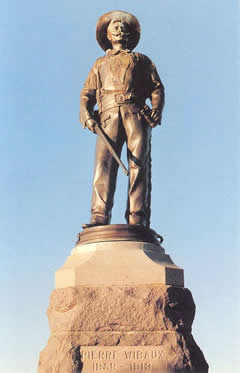Wibaux County Extension
|
A large bronze statue of Pierre Wibaux stands watch over Wibaux, Montana and the land he loved. Other visitor attractions include Mr. Wibaux's restored town house, an information center, museum, an old rock church and swimming pool. For information: Wibaux Chamber of Commerce, PO Box 159, Wibaux, MT 59353 Wibaux County, which came into existence August 17, 1914, is the third smallest county in the state with an area of 889 square miles. Wibaux County is a small rural agricultural county in eastern Montana on the North Dakota border. With a total population of 1068, the population density is 1.2 persons per square mile making Wibaux County a frontier county. The town of Wibaux is the only town in the county and the county seat with a population of 567 residents. The gateway to Montana has a rich history. The town of Wibaux and the county of Wibaux are both named for Pierre Wibaux, a Frenchman who gave up opportunities in his family's textile business to seek his fortune in the cattle industry of the American northwest. Arriving in the area in 1883, a young man of 27, Pierre established the W-Bar Ranch. He ran cattle on the open range in an area covering nearly 70,000 acres. By 1889, he had accumulated more than 40,000 head of cattle and employed 25 to 30 cowboys. The county's principal industry is agriculture. Cash receipts from crop production (hay and grain), livestock and livestock products yearly total over eight million dollars. Other major employers in the county include the school system, the nursing home, and county government. Wibaux County 4-H currently has three active clubs and a Cloverbuds program with a total enrollment of approximately 50 members and 20 leaders. The Extension staff consists of one full-time Agent and one full-time Program/Administrative Assistant. The programs of the MSU Extension Service are available to all people regardless of race, creed, color, sex, disability, or national origin.
|
 Photo by Jim Hardy Photo |
